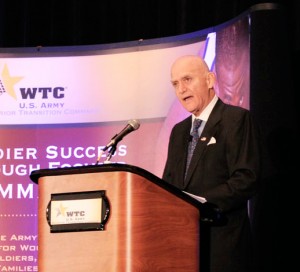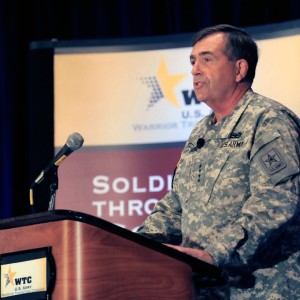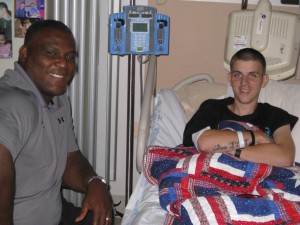By BG Darryl A. Williams, WTC Commander

John R. Campbell, Deputy Assistant Secretary of Defense for Wounded Warrior Care and Transition Policy, cited the Comprehensive Transition Plan as a very tangible example of the positive work done through the Warrior Care and Transition Program.
We are on a roll here in Orlando, FL. My staff did a super job planning this conference! More than 1,000 attendees spent the first two days training on the Comprehensive Transition Plan. When they return home they can help us standardize the transition planning process across the Army. Today we’re on to training segments focusing on interdisciplinary team members and warrior care improvement including: comprehensive pain management, adaptive sports, polypharmacy, force structure models, and internship opportunities.
We started the day with a presentation by John R. Campbell, Deputy Assistant Secretary of Defense for Wounded Warrior Care and Transition Policy. I have to say, he is a super advocate for the wounded, ill, and injured, and for the military and civilian men and women who take care of them. He made it clear he understands the challenges Soldiers face while coping with posttraumatic stress and the challenges of successful transitions back to the force or of leaving the military.
It’s great to know that we are definitely on the same page and moving in the same direction. We are both energized about education and employment for our Soldiers who transition out of military service. Mr. Campbell captured it perfectly when he said that “long after the guns are silenced, we have not succeeded if all of America does not hear the silence of the drums of war as a deafening call to action–a call to help lead our wounded warriors, the next greatest generation, into the classrooms as teachers, into the board rooms as executives, into their communities as small business owners and entrepreneurs , and into the lives of all Americans as leaders in their communities, their government, and back to their military to help others along the way.”
He reflected on his generation of Veterans who didn’t have the support they needed to overcome challenges and vowed it is a scenario he refuses to see repeated. Following his remarks, I had the opportunity to meet today with Warrior Transition Unit (WTU) commanders and NCOs; then with doctors, nurses case managers, social workers, pharmacists, physical therapists, and occupational therapists.
The reason I’m sharing this with you is twofold. One, to let you know that leaders in the warrior care arena, military and civilian, like me and like Mr. Campbell, are committed to providing the best possible support to today’s wounded, ill, and injured Soldiers. Second, the meeting with this group of WTU medical professionals was historic. It was the first time we got them all together, and they are an extraordinarily dedicated and impressive group who deserve a shout out! They do good work, they change lives, they are critical to the success of our wounded, ill, and injured warriors. They also realize that Families are integral to the success of Warriors in Transition and that they need and deserve the same care and attention we provide their loved ones.
I feel confident—and you should too—that together with Mr. Campbell’s office and with our partners the Marines, Navy, Air Force, and Veterans Administration, we can continue to improve and leverage resources internally and in local communities. An example of this is Judith Markelz. Mr. Campbell recognized her during his remarks so on behalf of the Army and Mr. Campbell, I too want to recognize her in this forum. She runs the Warrior and Family Support Center in San Antonio, TX. Ms. Markelz saw a need for a place where warriors and their Families could go to find resources, counseling, and a respite from their worries. She built the center from the ground up and people noticed. In 2008 $4 million was donated to the center for expansions, renovations, and improvements. It provides services to Soldiers and their Families and didn’t cost the Army a dime. So, kudos to Judith Markelz for her dedication, enthusiasm, and her selfless contributions to our wounded, ill, and injured warriors and their Families.
Folks, the bottom line here is that we’ve made great strides and we can continue to improve because our fight goes on. Know that I’ll stand with you to meet the challenges. Hooah.






